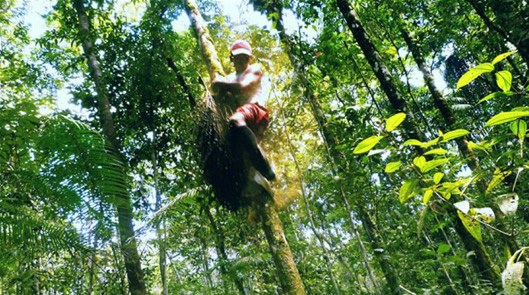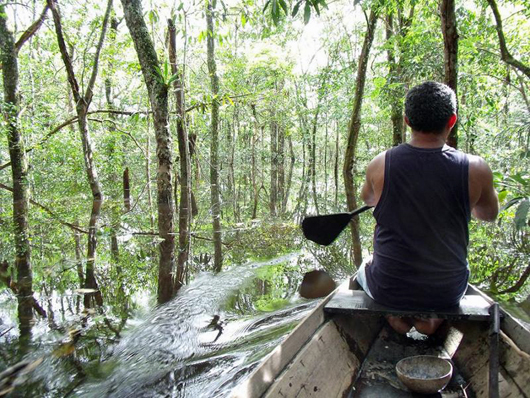Community botany for the community cooperative
The community botany partnership could help Xixuaú ensure the success of their new
community-owned cooperative: CoopXixuaú. This social enterprise complements the non-profit Amazon Association, by giving a legal basis for enterprising activities, particularly non-timber forest products, ecotourism and handicrafts. The first – non timber forest products – currently provides a small but essential cash income for the communities of the Jauaperi, mainly in the form of brazil nuts, açai fruits, and vines gathered from the forest, which are sold for basketry and broom-making. The community botany project aims to support identification of further opportunities for sustainable income generation from non timber forest products.

Raimundo Mendosa Horta (Castelo) during the seasonal harvest of açai (Euterpe precatoria). Cutting the fruit bunches from the top of the palms is not easy, but they make a delicious and nutritious drink that is appreciated locally and has reached the international market as a 'superfood' © Tomica Bajsic
The second objective of the cooperative is the production of handicrafts, which provides a much-needed cash income for women. They tend to play less of a role in harvesting forest products or guiding tourists, due to the need to care for children, but designing and making necklaces, earrings, bracelets and bowls fits into their lives more easily. The results are sold to the visiting tourists and are typically made from the seeds of forest trees and vines such as ‘tento’ (Ormosia spp.), ‘açai’ (Euterpe precatoria), ‘olho de boi’ (Mucuna urens), ‘morototo’ (Schefflera morototoni) and ‘tucumá’ (Astrocaryum aculeatum).

Jewellery designer Nadia Alves Barroso with her family and merchandise
© Tomica Bajsic
The final objective of CoopXixuaú is sustainable, community-owned ecotourism. Everyone has agreed a fair distribution of income: sharing food and cash between the families, and investing in infrastructure such as a new boat and tourist malocas (round wooden houses in the style of the neighbouring Waimiri-Atroari indigenous people). Small groups of tourists are drawn to Xixuaú by the chance to paddle through the flooded forest at high season, relax on vast beaches exposed at low water and experience traditional ribeirinho life far from the lodges of Manaus. As the community gets to grips with scientific knowledge of the region’s flora, it is hoped that this will add value to the touristic experience; new written guides could also help visitors understand and appreciate the environment they are visiting.

Raimundo Alves Barroso (Guri) paddles through the waters of the Jaueperi as they rise and fall several metres every year, flooding the forest along its margins. The trees in these forests are adapted to cope with this, and some of them depend on fish to disperse their fruit
© Annie Cooper
The Amazon Charitable Trust
This new charity was set up in London at the start of 2009, aiming to protect the Amazon rainforest by working with local traditional and indigenous communities. It is currently focused on a partnership with the Amazon Association, which it supports financially and through brokering regional and international contacts. The Trust has a particular interest in rainforest research, not least through its Chair Dr John Hemming (author, explorer and for many years director of the Royal Geographical Society), and is working to maximise the ongoing benefits from the community botany research, for local people and the international scientific community.
You can follow the progress of the Amazon Association and the Community Botany project on the Trust's blog.

Emanuela Evangelista of the Amazon Association in Italy, winner of the Italian environmentalist of the year prize 2009, gives an IT lesson in Xixuaú © Gianluca Colla, National Geographic
page 1 >
Partner links:
INPA (National Institute of Amazon Research)